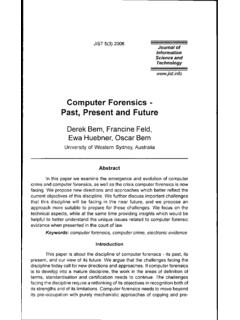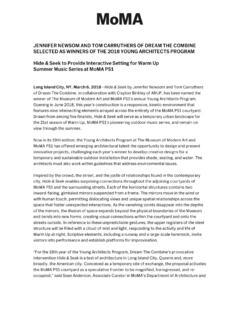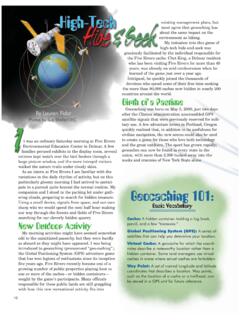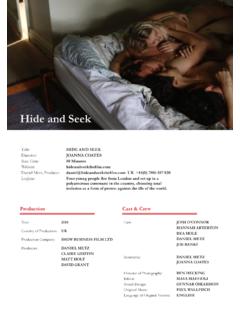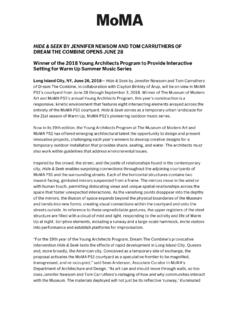Transcription of Lab 07 Stego v3 - J. Mack Robinson College of Business
1 1 of 10 CIS 8630 Business Computer Forensics and Incident Response Lab Protocol 07: Steganography and Its Detection with JP hide and seek and StegDetect Purpose: Ensure every student understands the hiding of data within images, and is able to make simple image steganographic encodings. Students will also develop first-hand knowledge in techniques for detecting and cracking steganography. Materials required: (all downloadable files) , , , Deliverable: This lab protocol with answers. Be sure your name and team name is on the material delivered. Preparation 1. Logon to your VM machine. 2. Onto your desktop, download the four zip files above from a. b. c. d. 3. Make a directory named Stego . Part One: Hiding data in a JPEG image using JP hide and seek 1. Unzip the contents of JP hide and seek ( ) into this directory. 2. From Windows Explorer, copy the file into the Stego directory.
2 Double-clicking on the photo to bring it up in the Windows Picture Viewer. This is a clean (no hidden data) photo of the 2009 Miss Georgia State University taken from and should look like the image to right. 3. Close the photo viewer. 4. From Windows Explorer, right click on the photo and choose Properties from the context menu. a. What is the exact size of the file containing this image? _____ 2 of 10 5. Examine the file that was downloaded with the zip file by double-clicking on the file. This file contains the secret information about the PTA Club members that we plan to hide in the image. 6. Run by double-clicking on the icon. After accepting the license terms, you should see the following screen: 7. Choose Open jpeg from the menu and open the JPEG image that was downloaded with the zip file. 8. JPHS will populate the input jpeg file information from the selected file.
3 Notice that it will specify a maximum file size that can be hidden within this image and recommend a limit that will make it less likely that the corruption of the image will be visually detectable. The screen should appear as follows 3 of 10 9. Check to see that your data matches the expected values: a. What is the recommended limit to the data file size that can be hidden in this image? _____ b. What is the maximum size for a data file that can be hidden in this image? _____ 10. From Windows Explorer, right click on the secret file, , and choose Properties . a. What is the exact file size of our secret file, PTAC? _____ b. Will this image be suitable, in terms of size, for hiding this data? _____ 11. Choose hide from the menu. You are prompted for a passphrase. This is the passphrase that will be needed to extract the hidden data. Lets choose the word sentence as our passphrase.
4 Enter and confirm the passphrase is sentence . Click OK . 4 of 10 12. You will be prompted to select the file containing the information to hide . Choose the file that we examined earlier: 13. JPHS will report the details of the file to be hidden. Notice that the values reported in JPHS are approximate. a. What is the JPHS reported size of the hidden file _____ b. According to JPHS, will this image be suitable, in terms of size, for hiding this data? _____ 14. Click on Save jpeg as . Save the file under the filename See below: 5 of 10 15. The JPHS screen will display the details of the three files approximately as below: 16. Note the difference in the input and saved JPEG files. From Windows Explorer, right click on the newly created image file and choose Properties from the context menu. a. What is the exact size of the file containing this image?
5 _____ b. Is the saved image file larger or smaller than the input image file? _____ c. Does the size of the hidden file determine the size difference between the input and saved image files? 6 of 10 _____ d. Why? 17. From Windows Explorer, double click on one of the two images to view it is the Windows Picture Viewer. Switch between the two images using the blue arrow keys and study the visual differences between the two images: a. What differences in these two images are detectable visually? 18. Close the viewer. Choose Exit from the JPHS menu to close JPHS. Part Two: Recovering hidden data in a JPEG image using JP hide and seek 1. As before, run by double-clicking on the icon and accepting the license terms. 2. Choose Open jpeg from the menu. Select the file (this file contains the hidden data). 3. Choose seek from the menu. A passphrase dialog box will open.
6 Enter our passphrase sentence into the dialog box passphrase and confirmation text boxes. Click OK . 4. A dialog box will open to allow you to choose a file name and location in which to deposit the recovered information. Enter the file name : 7 of 10 5. Open and check that the data contents are the same as the original file. Check the file sizes of the original hidden data file ( ) and the recovered data file ( ). a. What is the exact file size of _____ b. What is the exact file size of _____ c. Has the steganography changed the hidden data? _____ Part Three: Detecting hidden data in a JPEG image using StegDetect 1. Unzip the rest of the files in into the Stego directory. This file contains a number of JPEG images and one text file. 2. Unzip into the Stego directory. StegDetect is a steganography detection and cracking tool that is mainly aimed at unix-based computers, however these files contain a version that runs on windows computers.
7 3. Run the x-windows version of StegDetect by double clicking on : 8 of 10 4. Choose File and Open from the menu. The Select File dialog box will open: 5. Click OK to instruct StegDetect to search all files. The program will display its analysis results for all files. Non-image files in the directory will likely result in error messages: 9 of 10 a. List below any files that StegDetect suspects of containing hidden data with JP hide and seek : _____ _____ _____ 6. Choose File and Exit from StegDetect. Part four: Cracking stenographic passwords 1. Extract the contents of the file directly to your C:\ drive. The .zip file contains a folder named Usr. Do not modify or change this folder. It contains the required file structure needed for StegBreak for function. 2. From StegDetect, three files were shown to have hidden messages: 1) ; 2) ; and lastly, 3) , the program we ll use to crack the passwords is a DOS-based program.
8 It will be easier to run if the files with contained messages are in the same folder 3. Go to a DOS window by using CMD in RUN under the Start menu. Navigate to the Stego directory. in which you placed the zip file contents. An example of changing to the dayspace/ Stego directory is shown below: 3. The command syntax for the application can be found in file. 10 of 10 4. Make sure the dictionary used ( ) and the file are in the same directory as The syntax to run a dictionary attack is: stegbreak -r -f a) the name following the r parameter is the file. It comes with the program but must be in the same directory as stegbreak. b) the name following the f parameter is for the name of the dictionary to use. In this case, the dictionary s name is: ..which is found in this same DOS directory as the other files. c) stegbreak defaults to break jphide.
9 An additional parameter, t, can be used to crack outguess or jsteg-shell codes. See the file. d) NB: Avoid cut-and-paste for these commands (some characters may not be recognized by the Unix-based command). Also ensure the command window has administrator privileges (noted in the title bar). 5. The figure below shows the results of breaking the file file. See the password sentence delivered in the report. 6. What is the password for the hidden message in the file _____ 7. What is the content of the hidden message in the files _____ Hint: What type of file is shown below? What extension should you rename the file so that Windows will open it?
